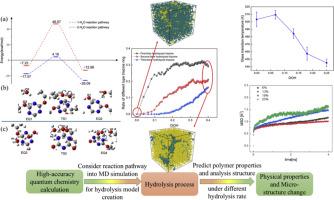高交联氰酸酯树脂的水解降解和性能老化:计算研究
IF 7.4
2区 化学
Q1 POLYMER SCIENCE
引用次数: 0
摘要
热固性树脂的水解降解显著降低了它们的玻璃化转变温度(Tg),限制了它们在潮湿条件下的性能。在这项工作中,我们提出了一个多尺度模拟框架,通过将高精度量子化学计算与传统分子动力学(MD)模拟相结合,利用水解-全局反应路径映射(GRRM)/蒙特卡罗(MC)/MD方法,阐明了中性环境下氰酸酯(CE)树脂的水解降解机制。通过GRRM方法确定了CE树脂的2-H2O水解机理,包括反应途径和反应能,并将其应用于MD模拟中,以构建真实的水解模型,预测降解引起的性能变化。物理化学性质分析证实,模拟的结构与实验观察到的结构非常相似。微观结构分析进一步表明,增加水解导致链迁移率增强和链刚度降低,从而加速材料物理性能的老化。这些结果为CE树脂的水解降解提供了分子水平的理解,并提供了湿度诱导聚合物老化的全面观点。这种集成的方法支持更耐用的聚合物材料的合理设计。本文章由计算机程序翻译,如有差异,请以英文原文为准。

Hydrolytic degradation and property aging in highly crosslinked cyanate ester resins: A computational study
The hydrolytic degradation of thermosetting resins significantly reduces their glass transition temperature (Tg), limiting their performance under humid conditions. In this work, we present a multiscale simulation framework to elucidate the hydrolytic degradation mechanism of cyanate ester (CE) resins under neutral environments by integrating high-accuracy quantum chemistry calculations with traditional molecular dynamics (MD) simulations, using a hydrolysis–Global Reaction Route Mapping (GRRM)/Monte Carlo (MC)/MD approach. A 2-H2O hydrolysis mechanism, including reaction pathway and reaction energy in CE resins, was identified via the GRRM method and implemented into MD simulations to construct realistic hydrolyzed models and predict degradation-induced property changes. Analysis of physicochemical properties confirms that the simulated structures closely resemble those observed experimentally. Microstructural analysis further reveals that increasing hydrolysis leads to enhanced chain mobility and reduced chain stiffness, thereby accelerating the aging of the material's physical properties. These results provide a molecular-level understanding of hydrolytic degradation in CE resins and offer a comprehensive view of humidity-induced polymer aging. This integrated approach supports the rational design of more durable polymeric materials.
求助全文
通过发布文献求助,成功后即可免费获取论文全文。
去求助
来源期刊

Polymer Degradation and Stability
化学-高分子科学
CiteScore
10.10
自引率
10.20%
发文量
325
审稿时长
23 days
期刊介绍:
Polymer Degradation and Stability deals with the degradation reactions and their control which are a major preoccupation of practitioners of the many and diverse aspects of modern polymer technology.
Deteriorative reactions occur during processing, when polymers are subjected to heat, oxygen and mechanical stress, and during the useful life of the materials when oxygen and sunlight are the most important degradative agencies. In more specialised applications, degradation may be induced by high energy radiation, ozone, atmospheric pollutants, mechanical stress, biological action, hydrolysis and many other influences. The mechanisms of these reactions and stabilisation processes must be understood if the technology and application of polymers are to continue to advance. The reporting of investigations of this kind is therefore a major function of this journal.
However there are also new developments in polymer technology in which degradation processes find positive applications. For example, photodegradable plastics are now available, the recycling of polymeric products will become increasingly important, degradation and combustion studies are involved in the definition of the fire hazards which are associated with polymeric materials and the microelectronics industry is vitally dependent upon polymer degradation in the manufacture of its circuitry. Polymer properties may also be improved by processes like curing and grafting, the chemistry of which can be closely related to that which causes physical deterioration in other circumstances.
 求助内容:
求助内容: 应助结果提醒方式:
应助结果提醒方式:


